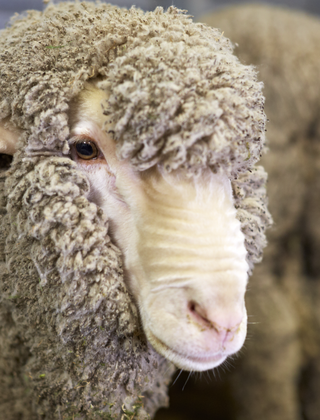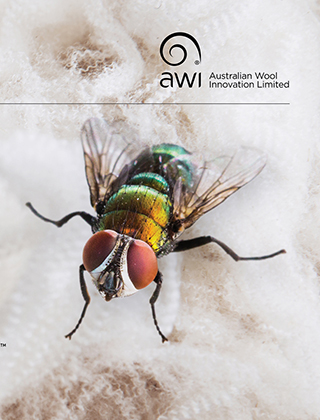Winning With Weaners lifts performance

AWI’s ‘Winning With Weaners’ workshop helps woolgrowers identify key management strategies to improve the lifetime performance of their Merino weaners.
Merino weaners have a reputation for not being the easiest part of a Merino flock to manage. But weaners are a vital part of any self-replacing Merino enterprise because they are the next breeders and wool growers.
Difficulties can arise because these young animals are trying to grow themselves as well their first fleece, and doing so when protein-rich feed from pastures often can be limited. As a result, weaner ill thrift can occur. This is when young sheep fail to thrive when other classes of stock in the flock are in satisfactory health and body condition.
Weaner ill thrift results in poor growth and fertility, reduced wool cut and wool quality (especially staple strength), increased susceptibility to disease (especially worms) – and can lead to high mortality rates in young sheep up to one year of age.
While there are multiple and often concurrent causes of weaner ill thrift and mortality, they are all primarily related to animal management and husbandry, with genetics only having a small effect.
“Weaners are a group of animals that will benefit from additional proactive management. It will pay you back with a productive and profitable contribution to your flock and business, for years to come,” said AWI National Extension Manager, Emily King.
“Joining length, feed quality, ewe condition, time of weaning, target weaning weight and average daily weight gain all play a role in the success of weaning. While effective management and timely weaning supports the lifetime productivity of the lambs, it also allows the ewes to recover condition before the next joining period.”

Merino weaners need to reach bodyweight targets to ensure the highest survival rates. Ewe weaners need to reach growth targets to achieve satisfactory reproduction performance as maiden ewes.
Industry recommendations to lift weaner performance
- Your minimum target weaning weight (TWW) is 45% of your ewes’ standard reference weight (SRW), the average weight of your mature ewes when not pregnant, bare shorn, condition score 3, no gut fill.
- Have a 5-week joining period to avoid a tail in the weaner mob.
- Imprint (train) lambs to eat supplementary feed prior to weaning.
- Use best practice lamb marking procedures (hygiene, vaccination, anaesthesia and analgesia, etc).
- Wean no later than 14 weeks from the start of lambing.
- Manage lighter weight lambs separately and feed them to achieve the target growth rates ASAP.
- Wean onto high quality pasture where possible and/or supplementary feed.
- Provide high quality, clean drinking water.
- Ensure good internal parasite control (monitoring and effective drenching).
- Regularly monitor weaner liveweight to reach target growth rates.
Winning With Weaners workshop

A Winning With Weaners workshop at Armidale, NSW.
To help woolgrowers improve weaner management of their Merino flock, in 2018 AWI launched a single-day workshop called ‘Winning With Weaners’.
“The aim of the workshop is to get a minimum of 95% of weaners surviving to one year of age, but also to thrive and be productive at hogget joining and throughout their life,” Emily said.
“The workshop identifies key practical actions and tools for commercial enterprises to implement on-farm to achieve this performance.”
Key themes of the Winning With Weaners workshop
- Understand the impact of weaning weight on the survival of weaners to first joining.
- Understand weaner nutrition, in terms of both energy and protein.
- Set weaner weight targets.
- Understand the importance of weaner management on lifetime performance of breeding ewes.
- Strategies for success – management calendar.
Woolgrowers Tony Overton from Walcha and Rob Kelly from Guyra in NSW’s New England region attended Winning With Weaners workshops in 2018. They recently featured in an episode of AWI’s The Yarn podcast in which they talked about how a few simple tweaks to their management has had them reaping the rewards of increased lifetime performance of their young Merino sheep.
Tony Overton manages a flock of Merino sheep on ‘Europambela’ at Walcha, joining about 8,000 superfine ewes that have 15 micron wool. Rob Kelly is the owner-manager of ‘Mt William’ at Guyra, that runs about 1,600 commercial Merino ewes with 17 micron wool.
“I did a Lifetime Ewe Management course about eight years ago that was really good at lifting our production, but although we were getting more lambs on the ground we weren’t getting to shear them all a year later. It was frustrating and I wanted to minimise the losses,” Tony Overton said.
“So I attended the Winning With Weaners workshop, from which there were some pretty simple management tips that I took home and applied on-farm, with good results.
“We want easy care sheep, and part of that is setting sheep up so they grow well for the first year of its life. If they do that, then they will get higher worm resistance, for example. Sheep are easy and good fun to work with, if they are healthy.”
Rob Kelly agrees that attending the workshop results in increased productivity.
“Our weaner management is now more focused, so that the weaners grow better and are healthier and happier. We get the first clip off them, monitor their weights to make sure they will make joining weight, and create our next generation of sheep,” Rob said.

“The Winning With Weaners workshop helped us see the value for our business of setting up our weaners for a lifetime of production.”
- Tony Overton, Farm Manager ‘Europambela’, Walcha
“The weaners are the building blocks to our enterprise; if we don’t have the weaners in 12 months then we’re missing out on their lifetime production.”
- Rob Kelly, Owner-Manager ‘Mt William’, Guyra
Standard reference weight
Both Rob and Tony say that one of the most important learnings from the workshop is to determine what the standard reference weight (SRW) is for your flock, set your weaning weight targets and track your progress.
“For many producers, there can be wastage in their system that just creeps up on them if they don’t monitor it,” Rob said. “So we’ve used our standard reference weight to determine our targets and we then weigh 10% of the weaners when they come through the yards and check that they are on target. If they aren’t, we change management to make sure we reach the target, like improving their feed or supplementary feeding.”
Tony says the SRW depends on your type of sheep but is a really good benchmark for what their growth rates should be.
“Growth rates might be above target or below target, depending on where you are through the season, but it’s important to know how they are going in case there needs to be some catchup with grass or a food wagon,” Tony added.
Protein vs energy
Young sheep have unique protein requirements that are different to grown sheep. If they don’t eat enough protein, then they are going to fall behind in their growth.
“For weaners, we need to be looking more at the protein (rather than the energy) that the pasture is able to provide,” Rob said.
“If we’ve got a lot of high protein, say clover, then that’s great, but as we get later in the year through our dry winters, the bit of standing feed on the ground can provide energy but it’s lacking in protein. So we then need to look at a high protein supplement to keep the weaners growing.”
Tony says that, without providing supplementary feed, his weaners couldn’t put enough weight on from his fescue-based pasture.
“So we went down the ryegrass track, brassicas and clovers, and it really quickly changed the dynamics. We still have a feed gap in the middle but it pushes our spring and autumn longer. Protein source is the key; if you haven’t got green grass, you haven’t got protein,” Tony said.
Lifetime performance
The aim of the Winning With Weaners workshop is to lift the lifetime performance of young Merino sheep, not just for the first year.
“The workshop sets them up for a lifetime of production,” Tony said. “The big winner isn’t just her good conception rate in her first year, but that conception rate keeps going on for the lifetime of that ewe because she’s put together better. In addition, her own lamb’s weaning weight goes up because the ewe is actually set up ready to have a lamb.”
Rob says his enterprise’s maiden ewe conception has improved since implementing the Winning With Weaners concepts.
“The workshop made me focus more on those young sheep that are coming through, rather than just on the older ewes. My original conception rate in maidens would have been 70 to 72% whereas now it would be around 89 to 92%,” said Rob.
Time saving
Woolgrowers might incorrectly assume that implementing the Winning With Weaners concepts might create a lot of time-consuming extra work.
“I actually think it’s saved us more time than what we did before,” Tony said. “The weighing and monitoring became so easy. If our weaners are in the yards for something else, we just run 40 or 50 over the scales; that gives us a good enough average to tell us where we’re tracking.
“Plus, if we hadn’t been monitoring them and the weaners got wormy for instance, then we’d need to do additional mustering, it takes longer to handle them, and would be more frustrating.”
Rob agrees, saying the weighing and monitoring doesn’t feel like “another job to do”.
“We’re bringing the sheep in to the yards at certain times anyway, so it’s pretty simple to just run a portion of them over the scales when they’re there and see how they’re tracking,” he said.
“Having a set of scales for your sheep and weighing those lambs is a pretty simple job. The benefits of the outcomes are far greater than the time it’s taken to weigh them.”
AWI resources for best practice weaner management
► Winning With Weaners workshop
The Winning With Weaners one-day workshop is run on a demand basis through the state-based AWI Extension networks. For further details about the workshop, head to www.wool.com/workshops. For details about your AWI Extension network, head to www.wool.com/networks
► Winning With Weaners Online
This one-hour recorded webinar, containing 30 slides, is a condensed version of the single-day Winning With Weaners workshop. It is available to view for free at www.wool.com/weaning
► AWI Change Makers (Episode 2): Weaning to manage
This 5-minute video outlines some key practical management tips. View the video at www.wool.com/weaning
► The Yarn podcast (Episode 253): Winning With Weaners
Hear from Tony Overton of Walcha and Rob Kelly of Guyra about how their Merino enterprises benefited after the woolgrowers attended a Winning With Weaners workshop. Head to www.wool.com/podcast
► Resources
The following essential resources are available to download at www.wool.com/weaning:
- Standard reference weight (SRW) calculator – This allows you to calculate the SRW for your flock, allowing for more accurate feed budgeting and management decisions.
- Weaner management checklist – This contains a checklist of the key management practices and targets for a thriving weaner mob.
- Feed budget tables for Merino weaners – Use these feed budget tables to first set your target weaning weight (TWW) and growth targets, then understand your weaners’ requirements based on the quality and quantity of feed you have available.
This article appeared in the March 2024 edition of AWI’s Beyond the Bale magazine. Reproduction of the article is encouraged.














